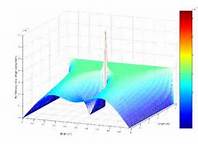
Several numerical methods can be used to solve ordinary differential equations. These equations are especially useful
when differential equations cannot be solved analytically.
The general form of the first-order equations can be expressed by:
and the higher-order equations can be written:
|
y(n) = f (x, y, y', y'',..., y(n-1)) |
The task is to determine the necessary boundary conditions and the relationships between x and y.
A common way of handling a second- or higher-order equations is to replace it with an equivalent system
of first-order equations. The higher-order equation above can always be transformed into a set of n first
order equations. Using the notation:
y0 = y
y1 = y'
y2 = y''
·
·
·
y(n-1) = y(n-1) |
then the equivalent first-order equations become:
y'0 = y1
y'1 = y2
y'2 = y3
·
·
·
y'n = f ( x, y0, y1,..., yn-1) |
Please select from the menu →
DIFFERENTIAL EQUATIONS (press to select)
|